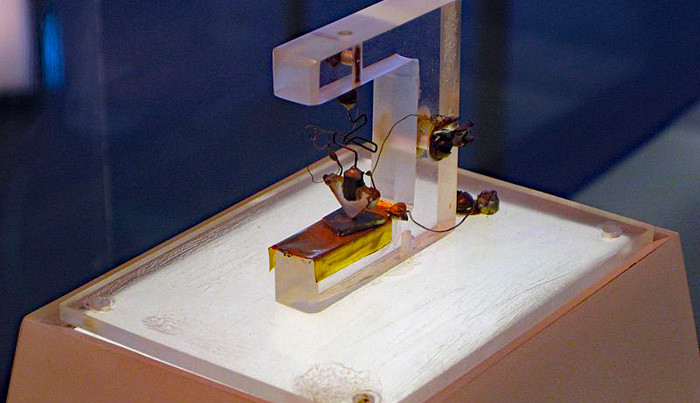70 years ago the transistor was born
December 27, 2017
on
on

It was the day before Christmas Eve in 1947 while working at Bell labs that John Bardeen, Walter Brattain and William Shockley managed to coax the first transistor into life. Without doubt, this was the signal that triggered the start of a huge technical revolution without equal.
Their ubiquity means we take them for granted. On some of today’s most highly integrated chips, there are more transistors packed together than there are people standing on the Earth and this trend is ever rising. Research is underway on the next generation of semiconductors with a structural width of only 7 nm which could well mark the physical limit to the Moore’s Law prediction. So far, it has been a long journey, driven by constant innovation.
At the famous Bell Labs in New Jersey between November and the end of December 1947 two researchers named Bardeen and Brattain (assisted by Shockley) developed and demonstrated the successful operation of a so-called ‘point-contact transistor ‘ which was the precursor to the ‘Bipolar transistor’ and successor to the bulky and energy-hungry vacuum tube. In 1956, the three researchers were awarded the Nobel Prize for physics for their game-changing invention. The Nobel committee got this one spot-on; John Bardeen is one of only two people to receive two Nobel Prizes in the same discipline (and the only one in physics).
From this first step into the world of the solid-state device the rate of new developments has escalated: as early as 1949 Werner Jacobi developed and patented the first known integrated transistor amplifier which was not ever commercially exploited. Jack Kilby was more successful with his integrated flip-flop consisting of two bipolar transistors on a germanium substrate. The first ‘genuine’ monolithic IC however was co-invented by Robert Noyce and patented in 1959. Throughout the 1950s a cost-cutting battle ensued between manufacturers of existing vacuum technology and the semiconductor new-boy on the block. Most of the now familiar major semiconductor manufacturers were founded in the 1960s.
Today we hardly give them a thought but we carry tens of billions of transistors around with us as a matter of course in the form of a smartphone. Most new devices designed today come equipped with some semiconductor technology. It’s the season for celebrating so engineers around the world can raise a glass to commemorate the transistor’s three founders and their inspiring Christmas breakthrough seventy years ago!
Their ubiquity means we take them for granted. On some of today’s most highly integrated chips, there are more transistors packed together than there are people standing on the Earth and this trend is ever rising. Research is underway on the next generation of semiconductors with a structural width of only 7 nm which could well mark the physical limit to the Moore’s Law prediction. So far, it has been a long journey, driven by constant innovation.
At the famous Bell Labs in New Jersey between November and the end of December 1947 two researchers named Bardeen and Brattain (assisted by Shockley) developed and demonstrated the successful operation of a so-called ‘point-contact transistor ‘ which was the precursor to the ‘Bipolar transistor’ and successor to the bulky and energy-hungry vacuum tube. In 1956, the three researchers were awarded the Nobel Prize for physics for their game-changing invention. The Nobel committee got this one spot-on; John Bardeen is one of only two people to receive two Nobel Prizes in the same discipline (and the only one in physics).
From this first step into the world of the solid-state device the rate of new developments has escalated: as early as 1949 Werner Jacobi developed and patented the first known integrated transistor amplifier which was not ever commercially exploited. Jack Kilby was more successful with his integrated flip-flop consisting of two bipolar transistors on a germanium substrate. The first ‘genuine’ monolithic IC however was co-invented by Robert Noyce and patented in 1959. Throughout the 1950s a cost-cutting battle ensued between manufacturers of existing vacuum technology and the semiconductor new-boy on the block. Most of the now familiar major semiconductor manufacturers were founded in the 1960s.
Today we hardly give them a thought but we carry tens of billions of transistors around with us as a matter of course in the form of a smartphone. Most new devices designed today come equipped with some semiconductor technology. It’s the season for celebrating so engineers around the world can raise a glass to commemorate the transistor’s three founders and their inspiring Christmas breakthrough seventy years ago!
Read full article
Hide full article


Discussion (0 comments)